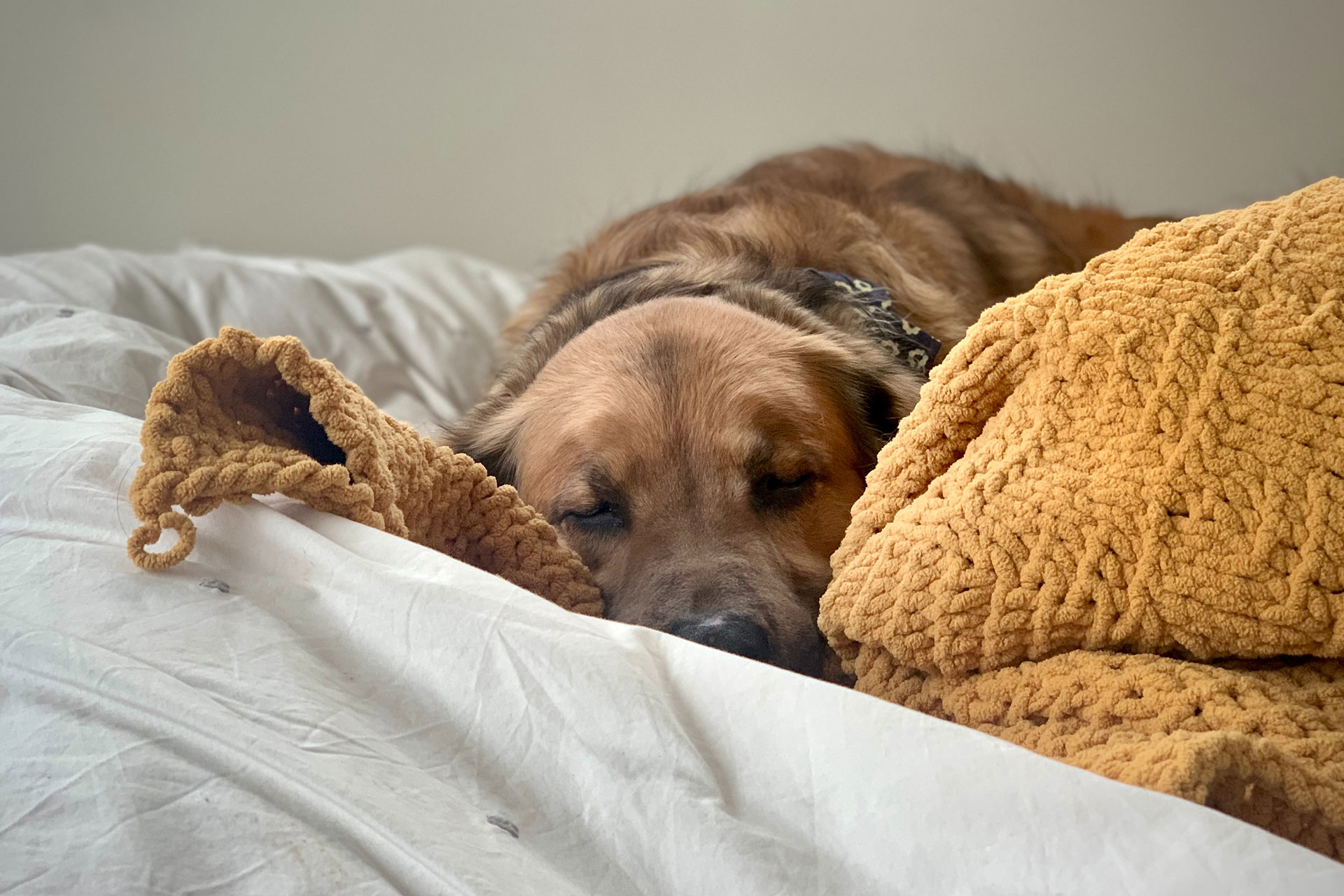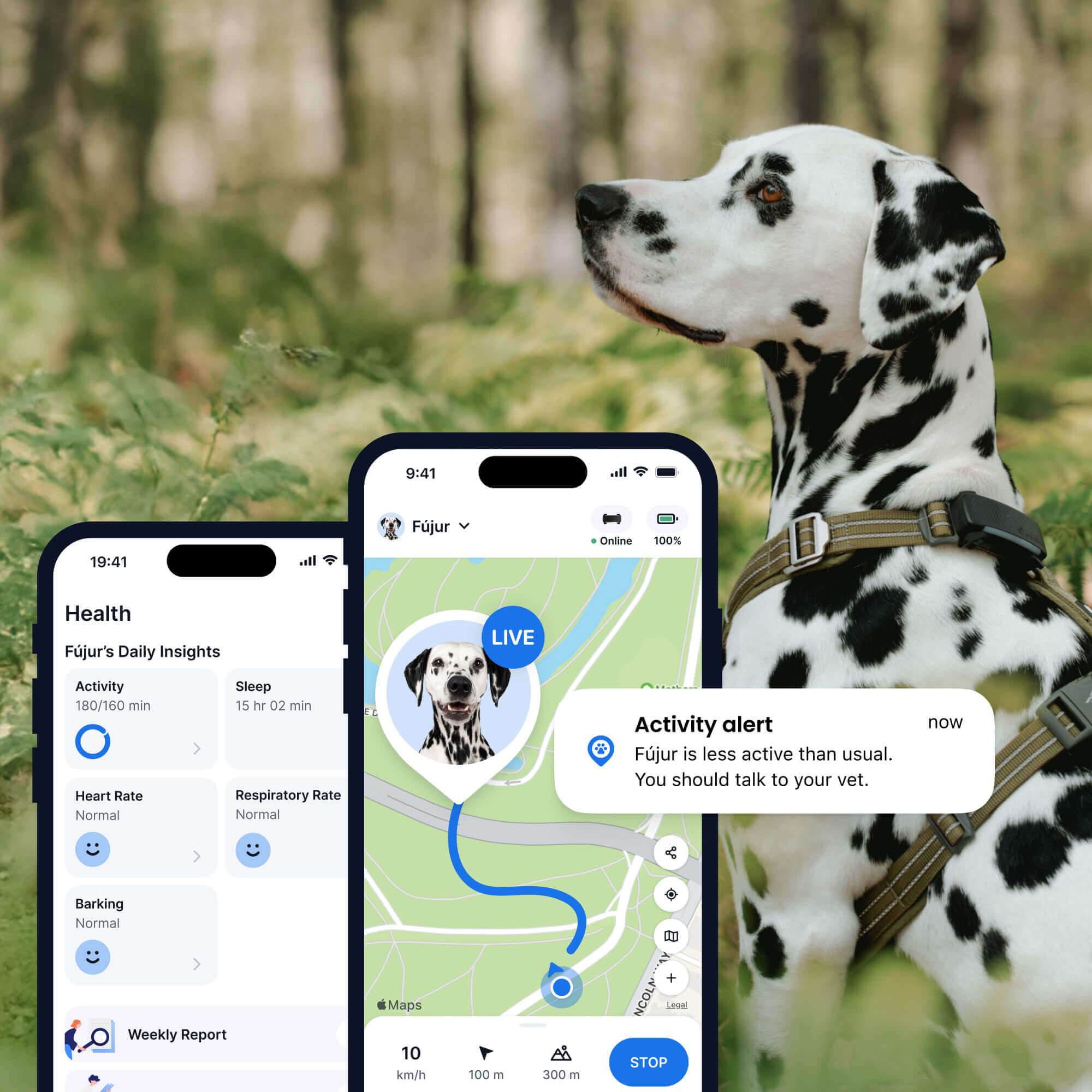Is Your Dog Sleeping More Than Usual? What You Need to Know
Boredom, anxiety - or an underlying health issue? Here are all the reasons why you might have a dog sleeping more than usual.

While there’s nothing cuter than a dog curled up in dreamland, you might start to wonder, “Is my dog sleeping more than usual?” It’s a common concern for dog parents, and a valid one. Dogs sleep a lot naturally, but a significant increase in their sleep habits can sometimes be a subtle sign that something’s amiss. Let’s dive into why your dog might be catching extra Z’s, when to head to the vet, and where a smart dog tracker can help you catch on to a change in your dog’s sleep and vital signs early.
Key Takeaways
Common causes for a dog sleeping more than usual include age (puppies and seniors), weather, or increased activity.
Head to your vet if you notice a significant, persistent increase in sleep, especially with other symptoms like lethargy, appetite changes, or pain.
A smart dog tracker with Health Monitoring features, like Tractive, can alert you to changes in your dog’s sleep patterns – helping you spot potential health issues early.

Always know your buddy is healthy & safe
Read more- Key Takeaways
- Why is my dog sleeping more than usual? The less-concerning reasons
- When increased sleep might signal a health issue
- When excessive sleep means time for a trip to the vet
- Prepping for your vet visit
- What to expect at your vet visit
- How a smart dog tracker can help you spot health issues early
Why is my dog sleeping more than usual? The less-concerning reasons
Most adult dogs sleep between 12-14 hours a day, including naps. So if you’re noticing your dog sleeping more than usual, it could also be due to:
- Age
Just like humans, puppies and senior dogs tend to sleep more. Puppies are growing and developing at an incredible rate, which requires a lot of energy and, consequently, a lot of sleep. Older dogs, on the other hand, naturally slow down. Their joints might ache a bit more, they have less energy, and their bodies simply need more rest to recover. - The weather
Bad weather, especially cold or dreary days, can lead to more indoor napping. Conversely, hot weather can also make dogs lethargic as they try to save energy and stay cool. - Activity
A long hike, an intense play session at the dog park, or even a busy day with visitors can exhaust your pup. So they need extra recovery sleep. Think of it as their body’s way of recharging. - Breed tendencies
Some breeds are just more prone to napping than others. Bulldogs, Mastiffs, Great Danes, and even some lapdog breeds (like Shih Tzus) for example, tend to nap more.1 On the other hand, working dog breeds like Retrievers or Border Collies tend to be more energetic. - Boredom
A dog without much to keep them bus at home when you’re not around might sleep extra to make up for the time. Puzzle toys, interactive treat dispensers, or even a dog sitter or walker to check up on them during the day can all help keep them active and busy. - Certain medications
Some medications, especially those for pain or anxiety, can have drowsiness as a side effect. Always check with your vet if you suspect a medication is causing excessive sleepiness.
💡A smart dog tracker with Health Monitoring can help you understand what’s a normal amount of sleep for your dog. So you can understand their usual habits, spot a change earlier – and take action that much quicker by bringing them over for a checkup.

Get health alerts for your dog
Our pups can’t always tell us if something’s wrong. But if their tracker detects unusual changes in their routine, you’ll get an alert, helping you catch potential issues early.
When increased sleep might signal a health issue
A dog sleeping more than usual – and also showing other signs of sickness – could be experiencing an underlying health problem. Including:
- Hypothyroidism
Which can lead to a slowed metabolism, resulting in lethargy, weight gain, hair loss, and, yes, increased sleep. - Diabetes
Which can result in fatigue due to their body’s inability to properly utilize glucose for energy. Watch out for other signs like increased thirst and urination. - Pain Including from dental pain or joint pain, which can make movement uncomfortable, leading dogs to be less active and seek more rest.
- Heart disease
A weak heart often struggles to pump blood efficiently, meaning less oxygen reaches the body’s tissues. This can cause fatigue, coughing, and reduced stamina. - Kidney disease
Which can lead to a buildup of toxins in the body, making your dog feel unwell and lethargic. Increased thirst and urination are common co-symptoms. - Infections
Bacterial, viral, or fungal infections can make dogs feel generally unwell, leading to increased sleep or even fever. - Cognitive dysfunction (Dementia)
In older dogs, cognitive decline can lead to changes in sleep patterns, including increased daytime napping and restlessness at night. - Anemia
A low red blood cell count means less oxygen is delivered to the tissues, leading to weakness, lethargy, and increased sleep. - Cancer
Which can cause generalized lethargy, weight loss, and increased sleep as the disease progresses.
When excessive sleep means time for a trip to the vet
Drop by for a checkup if you notice your normally energetic dog suddenly becomes a couch potato overnight. A few extra naps on a rainy day are fine, but if the increased sleep has been going on for several days or weeks, it might be a red flag. Also, keep an eye out for these symptoms:
- Lethargy (difficulty waking, disinterest in usual activities)
- Changes in your dog’s appetite or thirst
- Vomiting or diarrhea
- Reluctance to move, lameness, or signs of pain
- Weight loss or gain
- Changes in urination or defecation
- Behavioral changes (aggression, withdrawal, confusion)
- Difficulty breathing or coughing
⚠️ All of these can signal an underlying health issue, so head over to your vet right away if you notice these.
Prepping for your vet visit
Keep a detailed log of your dog’s symptoms. You’re more likely to have a productive vet visit if you know:
- When did the increased sleeping start?
- Has it been gradual or sudden?
- What other symptoms have you observed (appetite, thirst, urination, bowel movements, energy levels, behavior)?
- Any recent changes in diet, routine, or environment?
- Are there specific times of day your dog sleeps more?
- Is your dog on any medication or supplements?
- Has your dog recently been vaccinated? Or injured from an encounter with another animal?
In some cases, taking a video of your dog’s symptoms can help your vet identify any other cause of your dog’s excessive sleepiness. Like, for example, if they’re coughing or having difficulty moving around at home.
What to expect at your vet visit
Your vet will likely start with a thorough physical examination, checking everything from their eyes and ears to their heart and joints. Depending on their findings, they may recommend these diagnostic tests:
- Blood work
To reveal signs of infection, inflammation, anemia, kidney disease, liver disease, and thyroid issues. - Urinalysis
To check for kidney function, hydration, and also detect urinary tract infections or diabetes. - Fecal exam
To check for intestinal parasites. - X-rays
May be used to examine bones, joints, heart, and lungs for abnormalities. - Ultrasound
Provides a more detailed look at internal organs. - Other specialized tests
Depending on the suspected condition, your vet might suggest specific tests for hormonal imbalances, infectious diseases, or even neurological conditions.
How a smart dog tracker can help you spot health issues early
Tracking your dog’s sleep isn’t the easiest – it’s subtle, changes being easy to miss, and you do need to sleep yourself. That’s where a smart dog tracker with Health Monitoring can be an extra pair of eyes on your dog while you’re not around.
Strapped to your dog’s collar, your trusty Tractive device goes beyond just tracking your dog’s location. It also includes Health Monitoring features to help you better understand your dog’s well-being. With just a glance at your phone, you can now:
- Track your dog’s active & sleep minutes
Your Tractive tracker comes with a built-in motion detector to monitor your dog’s activity levels throughout the day, ensuring they’re getting enough exercise. It also tracks their sleep quality and duration. So you can understand what’s ‘normal’ for your dog, in the first place. - Spot potential health issues early
If there’s a weird change in their active or sleep minutes – like your dog sleeping more than usual or a dip in their sleep quality- you’ll receive a Health Alert right on your phone. Prompting you to get them over for a health checkup.
- Monitor your dog’s vital signs
Like if they’re breathing faster than usual, or if their heart rate seems elevated. All of which can be potential red flags, health-wise. - Keep an eye on any signs of anxiety
With your tracker’s built-in Bark Detection and Separation Anxiety Monitoring features. These monitor signs of anxiety, like excessive barking or restless pacing – and sends you an alert if detected.
This early warning system means you can spot potential health issues much sooner than you might with just observation alone. And with this data at hand, you’re more likely to have a more productive conversation with your vet.
Ultimately, understanding your dog’s sleep patterns is a key part of being a responsible dog parent. While a little extra nap time is often nothing to worry about, it’s wise to be aware of their habits and knowing when to head to your vet.
And if you’ve liked this post, share it with a friend or a loved one – and let’s help build a safer, kinder world for our furry friends together.




